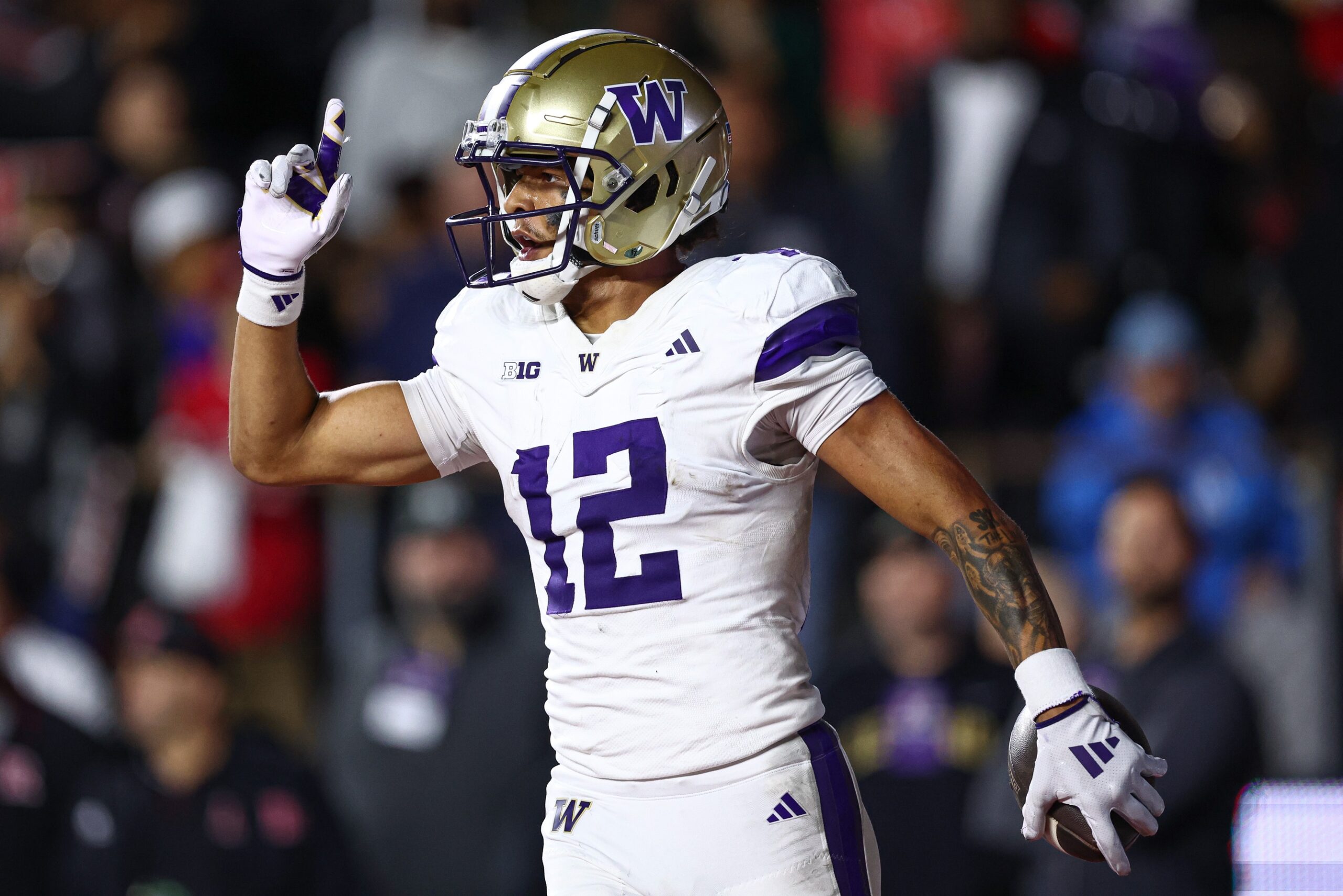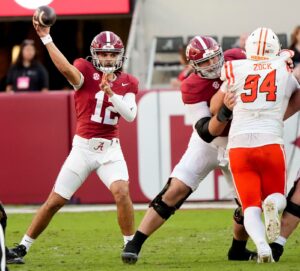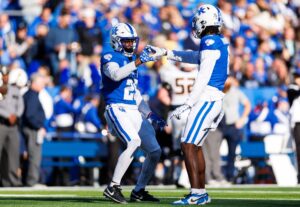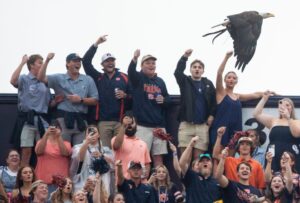Washington has now lost two games on the young season. The latest loss at Rutgers was despite a 521-yard performance on offense where Washington averaged nearly eight yards per play. But the Huskies scored just 18 points, with at least 16 more being left on the field. The loss has many pondering what the problem is with the Huskies this season. Head coach Jedd Fisch is operating a top-20 offense in college football, and Steve Belichick’s defense is 10th nationally in scoring allowing just 12 points per game. So is Washington’s problem play calling, or execution?
Red Zone Inefficiency
The Huskies are averaging just over seven yards per play this season with 470 yards per game. That ranks 21st nationally, but it doesn’t tell the story. Washington is 117th nationally in red zone offense. Will Rogers III has driven the Husky offense into the red zone 18 times on the season. Nine touchdowns and four field goals have resulted. The remaining five trips, however, have been crucial in Washington’s two losses.
In Piscataway on Friday, Washington was two of four with just 11 points in the red zone. The first red zone trip was immediately backed up by a false start penalty. Demond Williams Jr. ran the ball inside the five before a miscommunication led to an incomplete pass on third down. Washington settled for three.
The second trip inside the 20 was also backed up due to a penalty. This time the Huskies advanced to the Rutgers 13-yard line. But an illegal block moved them back 15 yards from the spot of the foul, leading to a long field goal attempt that was missed. Washington’s third red zone trip was on the heels of four straight run plays to move inside the five-yard line. The offense went to the air on the next two plays. Both passes fell incomplete.
Getting The Right Numbers
“I’d love to run it in if we could,” Fisch said on Monday regarding his red zone play calling. But numbers-wise in these situations, the head coach said that throwing the football was a better look. “When you get two over two or you get three over three and you have the chance to throw it, you gotta make that play.”
Washington had a two-over-two look on its first red zone trip on third and three at the four. Meaning, it had two cornerbacks lined up in man coverage over its two outside receivers. Numbers-wise, that’s a good look to pass the ball. “We unfortunately didn’t [convert] when it was two over two on third and four at the four,” Fisch said. Giles Jackson and Denzel Boston had single coverage, but the miscommunication led to an errant pass.
The offense again had the numbers to throw the ball in the red zone in the third quarter. On third down, Rutgers lined up with three cornerbacks over three Husky receivers. On the snap, Jeremiah Hunter hopped behind the line of scrimmage on a quick screen route to pull his defender down. It opened up a passing window for Rogers to Boston where the defender made a good play in tight coverage. The fourth down pass Washington again saw three over three but in a bunch trips set with a pre-snap motion. Jackson came open on the route, but the ball was batted at the line of scrimmage.
The Problem:
Against Rutgers, Washington’s play calling in the red zone didn’t seem to be the issue. On its two failed attempts in the red zone, Washington had the numbers it wanted in passing sets. A miscommunication and a defensive player making a play led to zero points for the Huskies.
Inopportune Penalties
Six penalties for 69 yards might not sound all that significant. But three of those penalties directly contributed to 14 Rutgers points, and a missed Washington field goal. The most egregious of which was the five-yard penalty for illegal substitution on a Rutgers field goal attempt. Washington blocked the kick, but Vincent Holmes left the sidelines to celebrate prior to the whistle. Rutgers was granted a first down on the penalty and scored a touchdown on the very next play.
“It was a freshman moment,” Jedd Fisch said of the redshirt freshman. “Too many guys celebrating while the play was going on, and not enough guys making a play on the ball.” In addition to the penalty, Fisch noted players not finishing the play. It was a game-turning special teams play that was negated because of a lack of discipline.
The Washington defense was also called for a facemask penalty early in the fourth quarter. The 15 yards extended the Rutgers drive that resulted in a 37-yard touchdown run. Earlier in the game, it was a 15-yard penalty for an illegal block that backed the Huskies into a long field goal try that was missed. That’s essentially 17 points that swung in favor of Rutgers on Friday.
The Problem:
Eight of the 16 penalties against Washington State were pre-snap penalties. Yet in that game, and against Rutgers, Washington was a play away from winning and forcing overtime, respectively. Penalties like this come down to discipline and execution on the field. But that certainly begins with coaching.
Physical Runners Causing Missed Tackles
Discipline issues aren’t just related to penalties. Washington’s tackling on Friday night at Rutgers was the worst it’s been all season. The Huskies missed 11 tackles against the Scarlet Knights. Cameron Broussard missed two in the contest. The Sacramento State transfer missed three total in 2023, a year where he had one of the highest tackling grades in the FCS. Kamren Fabiculanan also missed two tackles against Rutgers. Broussard and Fabiculanan both started at safety on Friday and played the most snaps of anyone on the Husky defense that night.
Missed tackles were also an issue in Washington’s first loss of the season in the Apple Cup. They missed 10 at Lumen Field. In Washington’s three other games this season against Weber State, Eastern Michigan, and Northwestern, the defense had a total of 13 missed tackles.
Rutgers’ Kyle Monangai and Samuel Brown V, and Washington State’s John Mateer are three bruising runners. Monangai has 363 yards after contact this season with an average of 3.75 per attempt. Brown averages 4.85 yards after contact per attempt. Mateer averages a head-turning 6.5 yards after contact per run with 66 rushing attempts this season. Against these three physical runners, Washington has struggled to complete tackles and contain yards. Washington allowed 136 rushing yards against the Cougars and 184 against the Scarlet Knights.
The Problem:
Missing tackles is something that falls into the on-field execution category with the defense. It relates back to Fisch’s comments relating to not finishing a play. The Husky defense has talented players who have flashed through five games. But it’s been inconsistent when faced with power running.
Big Ten Tailbacks Ahead
The Big Ten features some of the nation’s top bruising tailbacks. Next week, Michigan brings Kalel Mullings to town who has had three straight 120-plus yard games. The following week, Washington will face Iowa’s Kaleb Johnson. He’s the nation’s second-leading rusher who’s averaging 5.6 yards after contact per attempt. Penn State’s tandem of Kaytron Allen and Nicholas Singleton are also on the schedule. Five of Washington’s next seven opponents are ranked in the current AP Top 25. Washington begins its uphill climb as the calendar flips to October.






